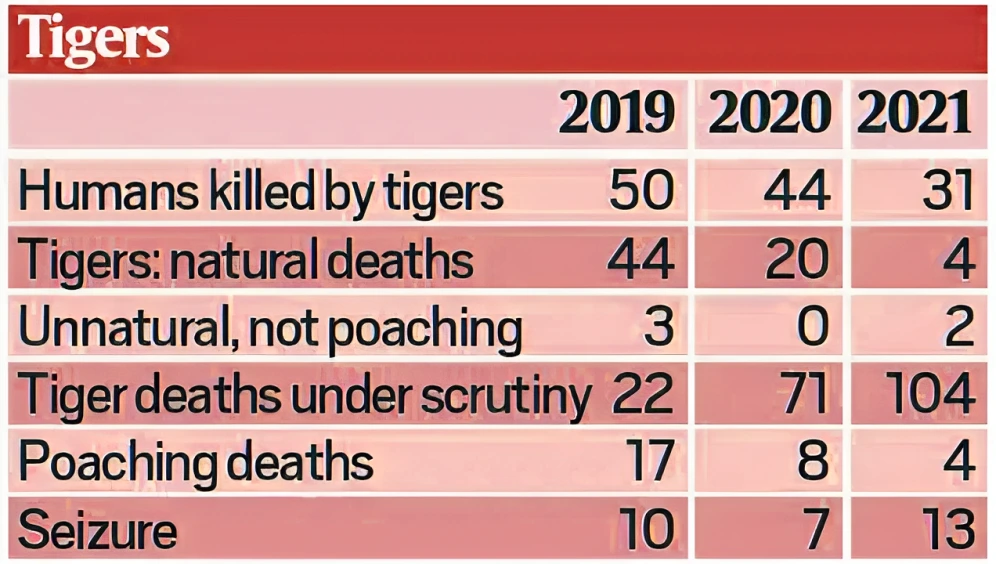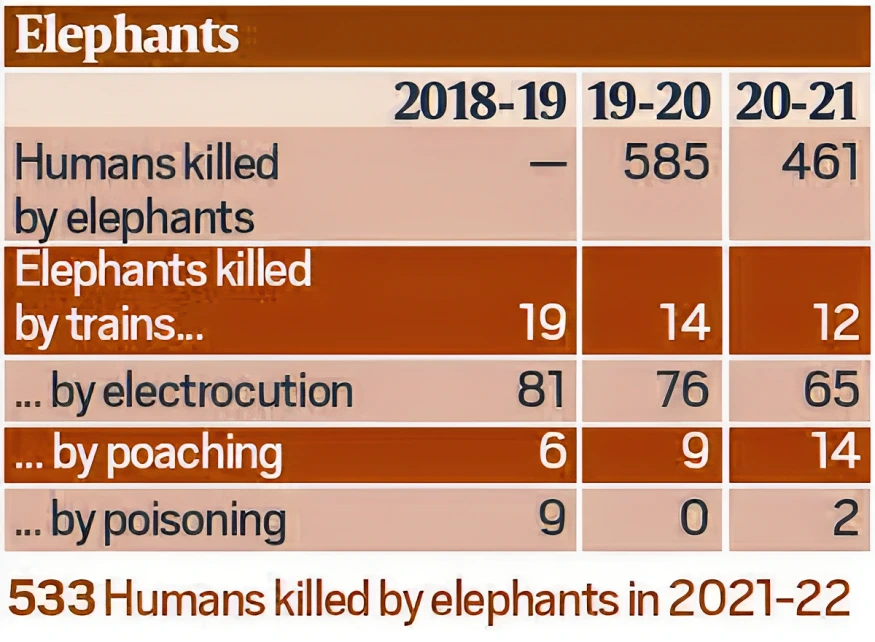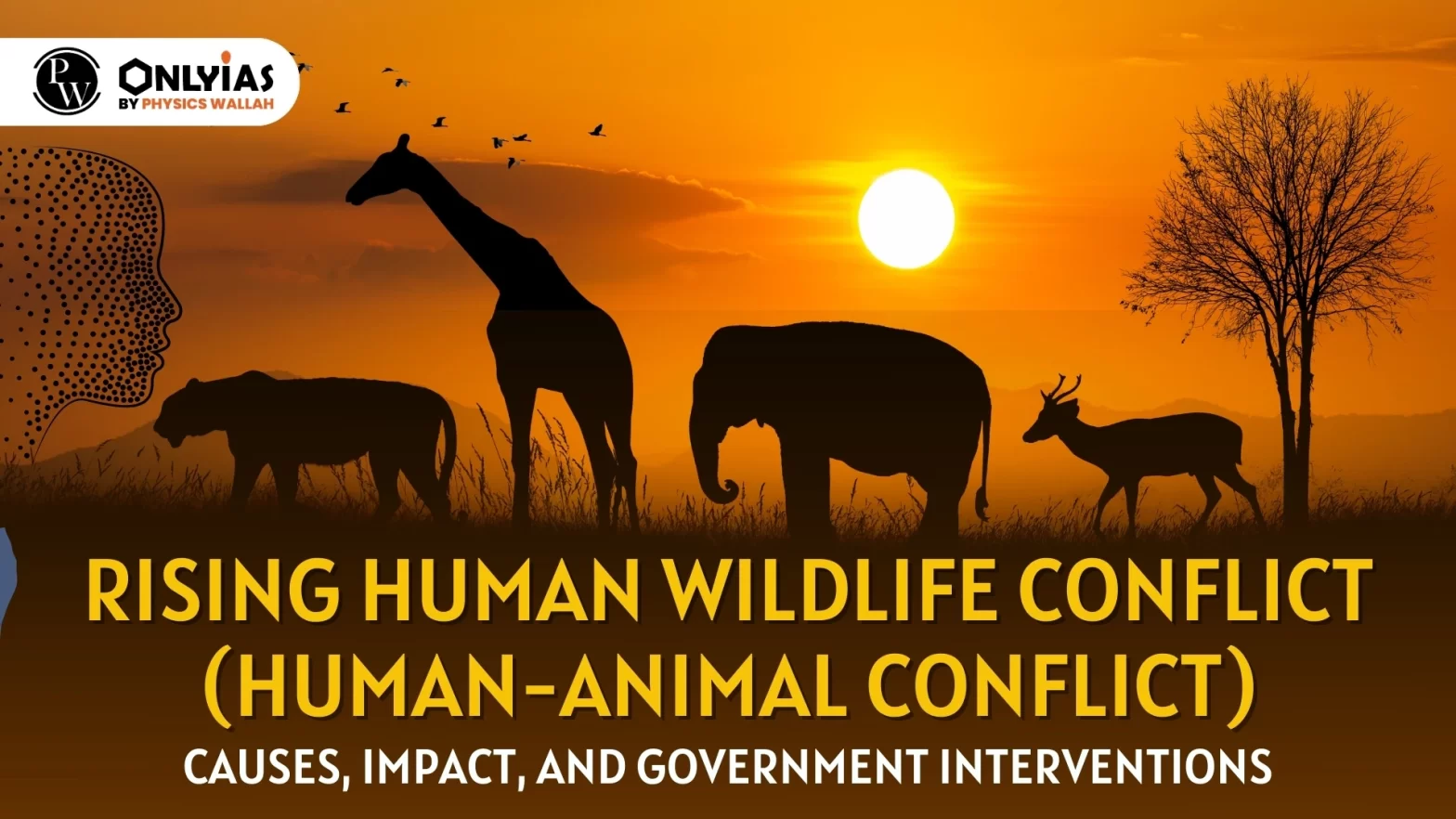Context: This article is based on the news “Escalating tiger-human conflict haunts Karnataka’s Mysuru, Chamarajanagar districts. Is big cat population spike to blame?” which was published in the Down to Earth. The Mysuru and Chamarajanagar districts in Karnataka reported five deaths in the last three months due to an increase in the number of tigers.
| Relevancy for Prelims: Wild Life (Protection) Act of India(WPA), 1972, Centre for Wildlife Studies (CWS), National Wildlife Action Plan, and National Board for Wildlife (NBWL).
Relevancy for Mains: Rising Human Wildlife Conflict (Human-Animal Conflict): Causes, Impact, and Interventions to Address Human Wildlife Conflict, and Way Forward. |
Latest Data On Increasing Human Wildlife Conflict
- Increasing Human Wildlife Conflict: According to forest officials, the death is on account of fighting among tigers.
- The recent increase in tiger and leopard populations, as well as the shrinking of forest area, has caused conflict in the region.
 The escalating animal-human conflict in the Mysuru region worries wildlife lovers and environmentalists.
The escalating animal-human conflict in the Mysuru region worries wildlife lovers and environmentalists. - As per the tiger census data of 2022 conducted by the National Tiger Conservation Authority (NTCA), Madhya Pradesh has the maximum number (785) of tigers in the country, with a 50 per cent increase in the last four years, followed by Karnataka (563), Uttarakhand (560), and Maharashtra (444).
- Toll on lives: The growing conflict between tigers and humans has led to a series of fatalities.
- A tiger killed a 54-year-old tribal man in the Bandipur Tiger Reserve who entered the forest to collect fodder for his goats.
 This conflict is not limited to humans, as big cats prey on numerous livestock and dogs every month.
This conflict is not limited to humans, as big cats prey on numerous livestock and dogs every month.
- Creation of Malai Mahadeshwara Hills (MM Hills) Tiger Reserve: It is proposed to be created in the district.
- As per the environmentalists, it will cause problems for devotees of the Male Mahadeshwara Swamy temple and other forest residents.
Must Read: INDIAN WILDLIFE CONSERVATION EFFORT
What is Human Wildlife Conflict?
- Definition: As per the report, titled, ‘A future for all – the need for human-wildlife coexistence’, human wildlife conflict is when encounters between humans and wildlife lead to negative results, such as loss of property, livelihoods, and even life resulting in suffering for both people and wildlife.
- Greater Impact on India: As per the report, India will be most affected by human wildlife conflict because it has the world’s second-largest human population as well as large populations of tigers, Asian elephants, one-horned rhinos, Asiatic lions and other species.
Human Wildlife Conflict: Causes
- Human Population Growth: The needs of an ever-growing population lead to encroachment in wildlife habitats and direct competition with local communities.
- High demand for land and natural resources intensifies the interactions between people and wildlife because they often share living space without clear boundaries.
- Habitat loss, degradation, and fragmentation: Species habitat loss, degradation, and fragmentation are interconnected with population growth and land use.
- Linear intrusions like roads and powerlines, quarrying, sand mining, and diversion of forest land for non-forest uses have created new forest edges.
- Changes in Land Use: Sub-urbanisation and the expansion of livestock grazing drive species to shift their territorial and movement behaviour. Thus, wild species come into more frequent contact with people.
| Recent Data Related To Human Elephant Conflict
As per data from the Union Ministry of Environment, Forest and Climate Change, over 500 elephants were killed between 2014-2015 and 2018-2019, mostly due to human elephant conflict.
- During the same period, 2,361 people were killed as a result of conflict with elephants.
- According to research by the Centre for Wildlife Studies (CWS), India is a high-wildlife, high-conflict country, with an average of 80,000 incidents reported per year to the government.
- CWS is a nonprofit that works on wildlife research, conservation, policy, and education
|
- Loss of crops and impact on livelihoods: Marginalised people face the brunt of elephants’ increasing reliance on crops. As many as 500 people are killed by elephants, and thousands of families face crop and property loss to elephants annually.
- Ecotourism and Increasing Access to Natural Reserves: The rise in recreational activities and growing public interest in wildlife species has increased human presence in protected areas.
- This has raised concerns about the ability to effectively manage and regulate public access and extensive use of protected areas.
- Climatic factors: It leads to changes in the flowering patterns of flowers, fruits, and foraging and forest usage patterns of animals.
- As animals change their movements, they tend to alter the ecosystem considerably. For instance, elephants are moving into Himachal Pradesh, and other colder areas of the country, where no sightings of elephants had been reported earlier.
- Alien Species Invasion: This is mainly caused by irresponsible imports and exports. Some invasions lead to the extinction of the native species as well as impact on the native environment.
- When elephants move in no native environments, they alter the existing forests, influencing the survival of a range of established species.
- Invasive species is a plant or animal species which is not native to an area and spreads rapidly in that habitat and has a negative influence on the native species and environment.
Kaziranga-Karbi Anglong Corridor
- Connects the elephant habitats of the Kaziranga National Park with the Karbi Anglong forest. The corridor area towards Kaziranga on the eastern side of National Highway 37 is mostly under agriculture.
- Threats: Heavy traffic on National Highway 37, agricultural land between the boundaries of Kaziranga National Park and National Highway 37.
Also Read: Gajraj System: Indian Railways to Install AI-Based Elephant Protection Software |
What are the impacts of Human Wildlife Conflict?
- Impact on Local Communities: The conflict with wildlife results in injuries and the loss of lives and of livestock, crops, or other property.
- Such negative impacts of Human Wildlife Conflict are exacerbated in vulnerable, poor, and marginalised communities that may lack alternative income sources.
- Ex- In the area around Bannerghatta National Park (BNP), crops are constantly exposed to elephant depredations.
- On an average, farmers in the region lose approximately an average of 10 quintals of ragi from an overall output of 15 quintals per acre of land.
- Impact on Wildlife: It is leading to engendering man-animal conflicts, revenge killing of carnivore animals, and poaching.
- For the prevention of public life, they are then captured and sentenced to a life inside enclosures.
- As per government data, in 2019-20 two tigers were imprisoned, which increased to five in 2020-21 and 2021-22, while in 2022, a total of seven tigers were imprisoned.
- According to the National Crime Record Bureau (NCRB) report, the number of people dying or getting injured due to animal attacks increased by 19 per cent in 2022 compared to 2021.
- Rise of zoonotic diseases: Zoonotic diseases transmitted from wildlife to humans and vice versa is a direct consequence of Human Wildlife Conflict.
- With increased contact between animals and humans, the likelihood of animal microbes transferring to people rises.
- The majority (70%) of emerging diseases (e.g. Ebola, Zika, Nipah encephalitis) and pandemics (e.g. avian influenza, HIV/AIDS, COVID-19) are zoonoses that are a direct consequence of Human Wildlife Conflict.
- Impact on Social Dynamics: The Human Wildlife Conflict has severe psychological impacts on people facing crop losses, damages to property, and loss of lives.
Government Interventions to Address Human Wildlife Conflict
- Wild Life (Protection) Act of India(WPA), 1972: The WPA, 1972 provides the legal framework for the protection of various species of wild animals and plants.
- It empowers the Chief Wildlife Wardens of the States to enable measures for the peaceful coexistence of humans and wildlife inside and outside national parks and sanctuaries.
- National Wildlife Action Plan 2017-2035 (NWAP): It has a dedicated chapter focused on managing Human Wildlife Conflict.
- It calls for developing national and regional conflict management plans, streamlining the process of providing post-conflict relief, and gathering relevant ecological information for the formation of local action plans.
- Advisory for management of Human Wildlife Conflict (Human-Animal Conflict): The Standing Committee of the National Board for Wildlife (NBWL) approved the advisory for the management of Human Wildlife Conflict in India.
- It provided important recommendations for the States/ Union Territories for dealing with Human Wildlife conflict situations and sought expedited inter-departmental coordinated and effective actions.
- Crop Insurance Coverage: The Pradhan Mantri Fasal Bima Yojana provides for crop compensation against crop damage due to Human Wildlife Conflict and augmenting fodder and water sources within the forest areas.
International Initiatives to Address Human Wildlife Conflict
- WWF Tigers Alive initiative: It developed an integrated Human Wildlife Conflict management approach in 2016 to address the dual challenge of recovering tiger numbers and addressing a potential increase in human-tiger conflict.
- IUCN SSC Human-Animal Conflict Task Force: It is a global advisory group and think tank that aims to support professionals working on Human Wildlife Conflict by providing interdisciplinary guidance, resources, and capacity building.
- Sonitpur Model by WWF India: WWF-India has worked to bring communities and the government together to address human-elephant conflict in parts of Assam.
- Low-Cost Electric Fencing: WWF India also developed a low-cost, single-strand, non-lethal electric fence to ease the guarding of crops from elephants.
- The project had brought dividends. For instance, in the Gohpur area of Biswanath district, crop losses dropped to zero for four years running.
- Human and elephant deaths also reduced significantly.
Way Forward to Address Human Wildlife Conflict
- Wildlife Compensation Funds: Compensation for losses resulting from conflicts is a crucial mitigation strategy.
- Many states allocate funds for wildlife compensation. However, the challenge lies in ensuring that individuals facing losses due to Human Wildlife Conflict access these funds.
- Centre for Wildlife Studies (CWS) through its award-winning Wild Seve programme, acts as a bridge, making sure that the claims are not rejected and that the applicants receive funding.
- Conflict Management Committee: As suggested by the Parliamentary standing committee, it should be formed to devise a mechanism to deal with conflict cases.
- It also suggested the inclusion of non-official members in the standing committee of the state wildlife boards.
- Making Human Wildlife Conflict goal of CBD: Make the coexistence of humans and wildlife a clear goal of the Convention on Biological Diversity’s (CBD) process, which aims to realise the 2050 vision of “living in harmony with nature.”
- Human Wildlife Conflict Inclusion under SDG: Include coexistence between humans and animals in the SDG framework’s implementation for long-term sustainable development and wildlife conservation.
- Well-planned stakeholder involvement: In Assam, India, many communities experience losses caused by wildlife which are located in remote areas, and have no one to help them.
- Linking these communities with government departments that have the mandate and ability to respond to human-elephant conflicts should be done.
- Holistic approach in addressing Human Wildlife Conflicts: It includes-
- Addressing the drivers of Human Wildlife Conflict Mitigation
- Strengthening the measures for effective prevention of Human Wildlife Conflict incidents
- Reduction of damage to people and wildlife, via crop alteration and compensation options, damage assessment methodologies, insurance options, value chain analysis etc.
- International Collaboration: Inter-State/ International dialogue to understand the issues better and seek cooperation for mitigation of Human Wildlife Conflict.
Conclusion:
The rising human wildlife conflict in Karnataka’s Mysuru and Chamarajanagar districts underscores the urgent need for comprehensive government interventions addressing the root causes, mitigating impacts, and fostering sustainable coexistence between humans and wildlife nationwide.
![]() 16 Dec 2023
16 Dec 2023

 The escalating animal-human conflict in the Mysuru region worries wildlife lovers and environmentalists.
The escalating animal-human conflict in the Mysuru region worries wildlife lovers and environmentalists.  This conflict is not limited to humans, as big cats prey on numerous livestock and dogs every month.
This conflict is not limited to humans, as big cats prey on numerous livestock and dogs every month.
